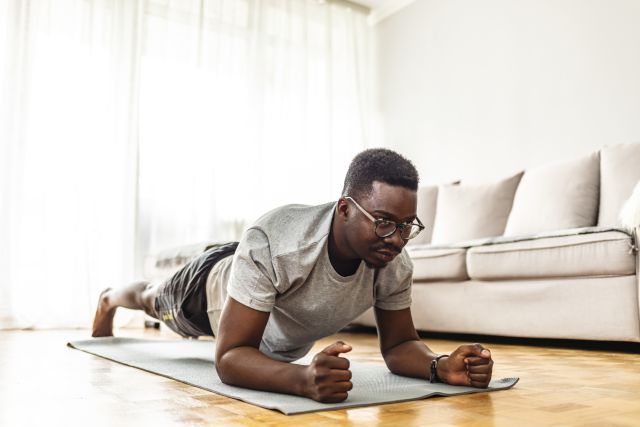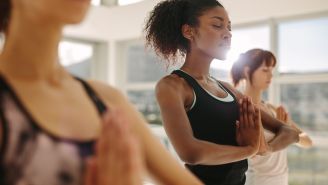Updated on June 25, 2024.
If you’re not a fan of gyms or dumbbells, there’s good news: Your own body is all you need to build muscle and strengthen bones. Here’s why body weight exercises may be right for you, plus simple but effective moves to get strong at home, on the road, or wherever you can fit in a workout.
Why you should strength train
As you age, it’s important to keep your muscles, bones, and joints strong. Strength training can help you continue to participate in daily activities, stay effective at work and home, and enjoy your favorite pastimes and hobbies. It can also help lower your risk of falls or injuries.
Remember, strength training isn’t only about building muscle. It’s also about holding onto the muscle you already have. As you get older, your body can lose four to six pounds of muscle every 10 years if you don’t do regular strength-training activities. Part of this is due to aging, but it can also happen in connection with inactivity, poor nutrition, and a variety of health problems.
Having less muscle means you’re not as strong, of course. But it also contributes to a higher risk of broken bones, since muscles support and strengthen bones. Low muscle mass also puts you at higher risk for injury, high blood pressure, osteoporosis (weakened bones), high cholesterol, a weakened immune system, and a lower quality of life, including trouble living independently and a shorter lifespan.
How to use your body weight to strength train
Gyms, treadmills, bikes, and weight machines are great ways to exercise, but they aren’t always available, affordable, or convenient. That’s where no-equipment workouts that use your own body weight come in: You don’t need a budget, fancy gear, or tons of space to do them. With this type of exercise, you can seize the moment in almost any place and time during your day—whether you’re in a hotel room, at the office, or watching your favorite TV show at home.
Adding quick workouts into your life makes it easy to keep up with your fitness. In turn, building and maintaining muscle makes it easier to keep up with your busy life.
Best body weight moves and expert recommendations
The Centers for Disease Control and Prevention (CDC) recommends that people do strength training at least twice a week (in addition to 150 minutes or more of weekly aerobic, or cardio, exercise). When you do strength training, just make sure you work all the major muscle groups: your legs, hips, back, core, chest, shoulders, and arms.
For muscle benefits, be sure to challenge yourself. That means doing enough repetitions (reps) of a motion so that it’s hard to keep going without help, but not so hard that you can’t maintain good form.
As a rule of thumb, the CDC suggests doing 8 to 12 reps per activity. That’s one set. For extra gains, do another set or two. Increase the number of repetitions or difficulty when it gets too easy.
Here are eight effective moves to try:
Push-ups
This exercise helps you strengthen not just your upper body, but also your core and lower body. It’s important to get the form right so you can get the most benefit while also avoiding injury.
To do a standard push-up, position yourself on all fours with your palms on the floor a little wider than shoulder-width. Extend your legs behind you, toes on the ground, and keep your feet the same width as your hips. Make sure your feet are straight, not turning out or in. Keep your hips in a straight line with your shoulders. Don’t let your hips slump toward the ground. If need be, you can raise your butt slightly to help keep your back supported.
Tighten your stomach muscles, squeeze your glutes (butt muscles), and bend your elbows to lower your body toward the ground. Pause for a moment, then push back up and away from the ground. Ideally, your elbows will be pointing back, rather than splaying out to the sides.
To make them easier, you can also do push-ups with your knees on the ground or with your hands on an elevated surface (like a bench). For added challenge, you can elevate your feet on a bench or chair so you push from a steeper angle.
Triceps dips
This move will work not just your triceps (the muscles on the backs of your upper arms), but also your shoulders and your anterior deltoids, which are the fronts of your shoulders, just above the armpits.
To do this exercise, find a solid, stable bench or chair. Sit down, then scoot forward off the edge, leaving your hands behind you on the bench shoulder-width apart and your body completely off the bench. Keep your knees bent at 90 degrees with your feet on the floor.
Engage your abdominal muscles and push your shoulder blades down and back. Slowly bend your elbows, lowering yourself down until your elbows form a 90-degree angle. Then push yourself slowly back up to the starting position. You should feel the challenge in your upper arms. If you feel pain or strain in your shoulders or armpits, back off from the exercise, as it can put stress on the shoulders.
Pull-ups/chin-ups
Pull-ups work many areas of your back, as well as your shoulders and arms. For this exercise, you’ll need to find something stable to use as a pull-up bar, which can be found at gyms and playgrounds. Home versions are also available to install over doorways.
To do a pull-up, put your hands on the bar with your palms facing away. Space them about shoulder-width or a bit wider. Tighten your abdominal muscles and push your shoulder blades down and back. Pull up toward the bar until your elbows and arms are right up against your sides. Slowly lower yourself down and repeat.
A chin-up is done using the same motion, only you grip the bar with your hands facing toward you.
Squats
This is a great total-body exercise that helps with your overall flexibility and strength. To do the classic squat form, stand so that your feet line up with your shoulders. Keep your feet straight with your toes pointing forward and keep your back straight. Engage your glutes, pull your shoulder blades back, and then slowly lower your body, keeping your chest up and facing forward. Imagine yourself sitting down onto an imaginary stool, set at about knee-height.
Take about four seconds to lower yourself, then come up more quickly, pushing your pelvis forward as you complete the move. Make sure you don’t let your knees move inward and try to keep your knees above your toes (rather than letting your knees move too far in front of your toes.) Try not to lean your upper body forward too much or come up onto your toes. Your weight should be evenly spaced through your feet during the entire move.
Lunges
Lunges also help strengthen your lower body. The classic upright lunge is basically a squat with one difference: one of your feet will be behind you and one will be in front of you while you lower your body, with each knee ultimately bent at a 90-degree angle. This kind of lunge will strengthen your quadriceps, which are the big muscles at the front of your thighs.
You can do forward lunges or reverse lunges. Reverse lunges tend to be easier on the knees.
Stand upright with feet shoulder-width apart. Looking forward and maintaining your balance, take one long step backward with your right foot. You should land your right foot on your toes while you bend your left leg at a 90-degree angle. Your right leg bends at a similar angle and your right knee moves toward the floor. Pause just before the right knee touches the floor, then step forward again with your right leg to come back to a standing position. Do all your reps on one leg and then your next reps on the other leg, or alternate right and left for your full set.
Single-leg step-ups
When you use just one leg for a strengthening exercise, you work that leg twice as hard as usual, since it can’t share the effort with your other leg.
Single-leg step-ups are simple. Find a sturdy, low box, block, or bench that can support your weight and stand facing it. You can also do this move on on the bottom stair of a staircase. Put your left foot on the bench or stair. Pushing down into your heel, lift your body and your right leg up. Draw your right leg all the way up, as if you’re marching, but don’t let it touch the bench or stair. Hover your right foot over the bench or stair for a moment, then put your right leg back on the ground, pause, and repeat the motion. Do all your reps on the left leg, then repeat on the other side.
Box jumps
This exercise combines a squat with a jump and it works your hamstrings, thighs, glutes, and calves. You’ll need a wide step or platform that can support your weight about six inches high or more.
With your feet about shoulder-width apart and pointing straight ahead, engage your abdominal muscles. Bring yourself quickly down into a squat, but not fully—go about a quarter as far as you normally would for a squat. Pull your arms to your sides, then jump forward and up, pulling your arms over your head, and land on the box. Make sure you’re balanced, then step off the box before doing your next jump.
Planks and plank variations
A plank can help you strengthen your core and give you better posture. To do a standard plank, lie on your stomach with your feet together. Put your palms on the ground so that they line up with your shoulders. Engage your stomach muscles and glutes, then slowly lift your body up off the floor until your whole body is in a straight line as if you were about to do a push-up. Hold this pose for as long as you’re able.
There are many variations on the standard plank. Instead of resting on your palms, you can also do a plank on your forearms, with your shoulders and elbows lined up vertically. To make a standard plank more challenging, you can try the move with your feet elevated about six inches off the ground or raise either a foot or a hand off the floor.
You can also try a side plank. This strengthens the muscles that support your pelvis, hips, and spine. Lay on your side with your feet together and your forearm on the floor, making sure the shoulder and elbow line up. Bracing yourself with your forearm, engage your abdominal muscles and glutes and raise up your hips so that your whole body creates a straight diagonal line from your feet to your head. Hold the pose steady for as long as you’re able.
If you do a little bit of strength training each day, it can make a difference. Remember, any exercise is better than no exercise, and the more you do, the bigger the health benefits.







